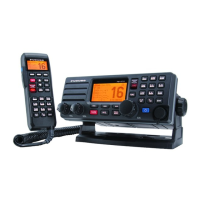7. MAINTENANCE, TROUBLESHOOTING
7-2
7.2 Troubleshooting Chart
Symptom Probable cause Remedy
Transceiver cannot
be powered.
No DC voltage to the transceiv-
er, or blown fuse
• Check the 10.8 - 15.6 VDC battery con-
nections and the fuse.
• The (power) button needs to be
pressed and held to turn the radio on.
Transceiver blows
fuse when connected
to power supply.
Reversed polarity of power
wires
Check the power cable for DC voltage, or
replace the fuse (6A 250 V).
Make sure the red wire is connected to
the positive (+) battery post, and the black
wire is connected to the negative (-) bat-
tery post. If the fuse still blows, contact
your dealer.
Popping or whining
noise from the speak-
er while engine runs.
Engine noise Reroute the DC power cable away from
the engine. Add a noise suppressor on
power cable. Change to resistive spark
plug wires and/or add an alternator whine
filter.
Sound is not emitted
from the internal or
external speaker.
Accessory cable Check the connections of the accessory
cable for short circuit on external speaker
cable (WHITE & SHIELD).
Sound is not emitted
from the PA speaker.
Accessory cable Check the connections of the accessory
cable for short circuit on PA speaker ca-
ble. (RED & SHIELD).
Receiving station re-
ports low transmit
power, even with
HIGH power.
Antenna Have the antenna checked or test the
transceiver with another antenna. If the
problem persists, contact your dealer.
The message "HI
BATTERY" or "LO
BATTERY" appears
when the power is
turned on.
The power supply voltage is too
high or too low.
Confirm that the connected power supply
voltage is within 10.8 - 15.6 VDC.
Your position is not
displayed.
Accessory cable. Check the accessory cable connection.
Setting of the GPS receiver Check the output signal format of the
GPS receiver. This radio requires the
GLL, RMB, or RMC sentence as an out-
put signal. If baud rate and parity can be
set on the GPS receiver, select them to
4800 and NONE, respectively.

